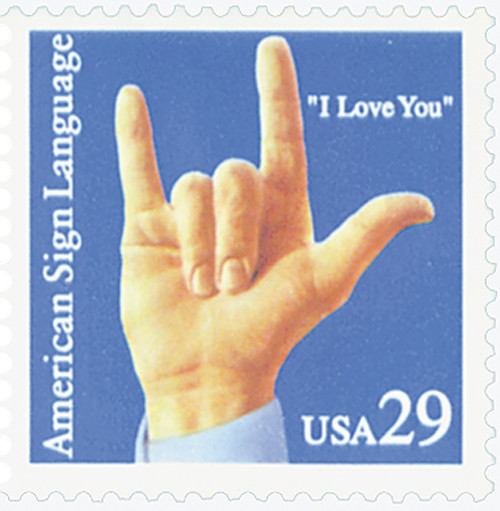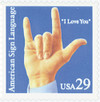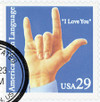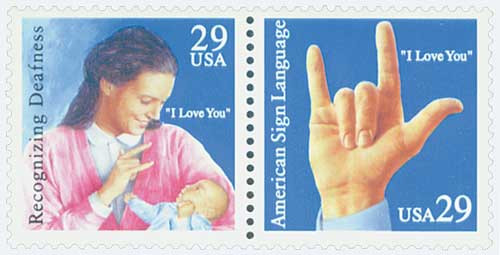
# 2784 - 1993 29c American Sign Language: "I Love You"
U.S. #2784
1993 “I Love You” – American Sign Language
- Brings awareness to the deaf and hard-of-hearing community as well as one of the ways they communicate – American Sign Language
- One of two stamps in the American Sign Language set
- Only the second time in 12 years the USPS issued a se-tenant pair of stamps
- Issue date moved from August to September to coincide with Deaf Awareness week
Stamp Category: Commemorative
Set: American Sign Language
Value: 29¢, First Class Mail Rate
First Day of Issue: September 20, 1993
First Day City: Burbank, California
Quantity Issued: 83,680,000
Printed by: Stamp Venturers (printed in Richmond, Virginia, perforated in Milwaukee, Wisconsin)
Printing Method: Photogravure (webfed gravure press)
Format: Pane of 20 (square, 4 across, 5 down)
Perforations: 11.6 (sheetfed stroke perforator)
Tagging: Prephosphored paper
Why the stamp was issued: To satisfy the National Institute on Deafness and other Communication Disorders (NIDCD), the National Association of the Deaf (NAD), and the American Postal Workers Union (APWU), all of whom had been advocating for the production of an American Sign Language stamp (although the NAD was unaware the American Sign Language stamps were in the works – they had been advocating for the release of a Love stamp picturing the American Sign Language sign for “I Love You”). Only one stamp was planned originally, before the decision was made to create two.
About the stamp design: The NIDCD gave the USPS a number of reference materials for use in creating the American Sign Language stamp designs. Art director Richard Sheaff and artist Christopher Calle worked together to create several sketches and captions. This design pictures a hand signing “I love you.” Calle created the final design with a combination of watercolors, colored pencils, and dyes.
Special design details: The image was based on Calle’s observation of several friends whom he asked to sign “I Love You” for his reference. Calle would have used his own hand as reference, but could only make the sign with his right (dominant/drawing) hand, “When I try it with my left hand, my two middle fingers kind of criss-cross… And when I have them straight down, my pinky won’t go straight up. I literally would have to hold it up with my right hand.”
First Day City: Both American Sign Language stamps were issued in Burbank, California, the location of TRIPOD, a program putting deaf and hearing students in the same classes in public schools. The program is a form of “bilingual” learning as all students use sign language whether they are deaf or hearing.
About the American Sign Language set: The set was originally supposed to be a single design, but there ended up being two designs the NIDCD and APWU liked. USPS project manager Elizabeth Altobell said “The two designs worked together so well… I don’t think Chris Calle had intended it that way, but when we started looking at them side by side on the table, each with a blue background, we asked: ‘Why do we have to choose one design when we can do two?’”
History the stamp represents: As many well-known individuals such as Ludwig van Beethoven, Helen Keller, and Marlee Matlin have proven, deafness need not hinder one’s achievements. Thanks to the work of pioneers like Thomas Hopkins Gallaudet (co-founder of the first permanent institution for the education of the deaf in North America) and Alexander Graham Bell (lifelong proponent of deaf education – he even helped find a suitable teacher for Helen Keller), deaf people lead very rich and fulfilling lives.
Using a philosophy known as “total communication,” which includes sign language, lip reading, and oral speech, deaf people can now communicate with one another, as well as with hearing individuals. Today, many deaf people in the US use American Sign language, which is based on ideas and concepts, rather than individual words. The “I Love You” is one such sign. It combines three letters from the manual alphabet (where different finger positions represent each letter of the alphabet) – I Love You – to form one sign.
Developed in France at the Institute Royal des Sourds-Muets, the manual (or sign) method was brought to the US by Thomas Hopkins Gallaudet, who together with Laurent Clere founded the Hartford School for the Deaf in 1817. His son Edward later founded Gallaudet University – a liberal arts college exclusively for the deaf, in Washington, DC.
U.S. #2784
1993 “I Love You” – American Sign Language
- Brings awareness to the deaf and hard-of-hearing community as well as one of the ways they communicate – American Sign Language
- One of two stamps in the American Sign Language set
- Only the second time in 12 years the USPS issued a se-tenant pair of stamps
- Issue date moved from August to September to coincide with Deaf Awareness week
Stamp Category: Commemorative
Set: American Sign Language
Value: 29¢, First Class Mail Rate
First Day of Issue: September 20, 1993
First Day City: Burbank, California
Quantity Issued: 83,680,000
Printed by: Stamp Venturers (printed in Richmond, Virginia, perforated in Milwaukee, Wisconsin)
Printing Method: Photogravure (webfed gravure press)
Format: Pane of 20 (square, 4 across, 5 down)
Perforations: 11.6 (sheetfed stroke perforator)
Tagging: Prephosphored paper
Why the stamp was issued: To satisfy the National Institute on Deafness and other Communication Disorders (NIDCD), the National Association of the Deaf (NAD), and the American Postal Workers Union (APWU), all of whom had been advocating for the production of an American Sign Language stamp (although the NAD was unaware the American Sign Language stamps were in the works – they had been advocating for the release of a Love stamp picturing the American Sign Language sign for “I Love You”). Only one stamp was planned originally, before the decision was made to create two.
About the stamp design: The NIDCD gave the USPS a number of reference materials for use in creating the American Sign Language stamp designs. Art director Richard Sheaff and artist Christopher Calle worked together to create several sketches and captions. This design pictures a hand signing “I love you.” Calle created the final design with a combination of watercolors, colored pencils, and dyes.
Special design details: The image was based on Calle’s observation of several friends whom he asked to sign “I Love You” for his reference. Calle would have used his own hand as reference, but could only make the sign with his right (dominant/drawing) hand, “When I try it with my left hand, my two middle fingers kind of criss-cross… And when I have them straight down, my pinky won’t go straight up. I literally would have to hold it up with my right hand.”
First Day City: Both American Sign Language stamps were issued in Burbank, California, the location of TRIPOD, a program putting deaf and hearing students in the same classes in public schools. The program is a form of “bilingual” learning as all students use sign language whether they are deaf or hearing.
About the American Sign Language set: The set was originally supposed to be a single design, but there ended up being two designs the NIDCD and APWU liked. USPS project manager Elizabeth Altobell said “The two designs worked together so well… I don’t think Chris Calle had intended it that way, but when we started looking at them side by side on the table, each with a blue background, we asked: ‘Why do we have to choose one design when we can do two?’”
History the stamp represents: As many well-known individuals such as Ludwig van Beethoven, Helen Keller, and Marlee Matlin have proven, deafness need not hinder one’s achievements. Thanks to the work of pioneers like Thomas Hopkins Gallaudet (co-founder of the first permanent institution for the education of the deaf in North America) and Alexander Graham Bell (lifelong proponent of deaf education – he even helped find a suitable teacher for Helen Keller), deaf people lead very rich and fulfilling lives.
Using a philosophy known as “total communication,” which includes sign language, lip reading, and oral speech, deaf people can now communicate with one another, as well as with hearing individuals. Today, many deaf people in the US use American Sign language, which is based on ideas and concepts, rather than individual words. The “I Love You” is one such sign. It combines three letters from the manual alphabet (where different finger positions represent each letter of the alphabet) – I Love You – to form one sign.
Developed in France at the Institute Royal des Sourds-Muets, the manual (or sign) method was brought to the US by Thomas Hopkins Gallaudet, who together with Laurent Clere founded the Hartford School for the Deaf in 1817. His son Edward later founded Gallaudet University – a liberal arts college exclusively for the deaf, in Washington, DC.









